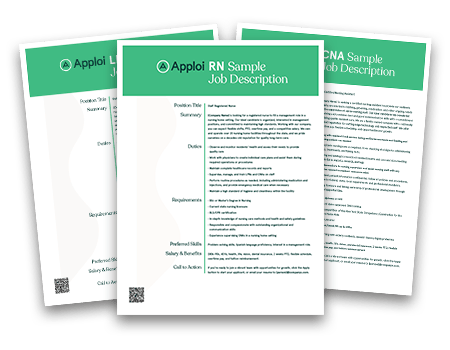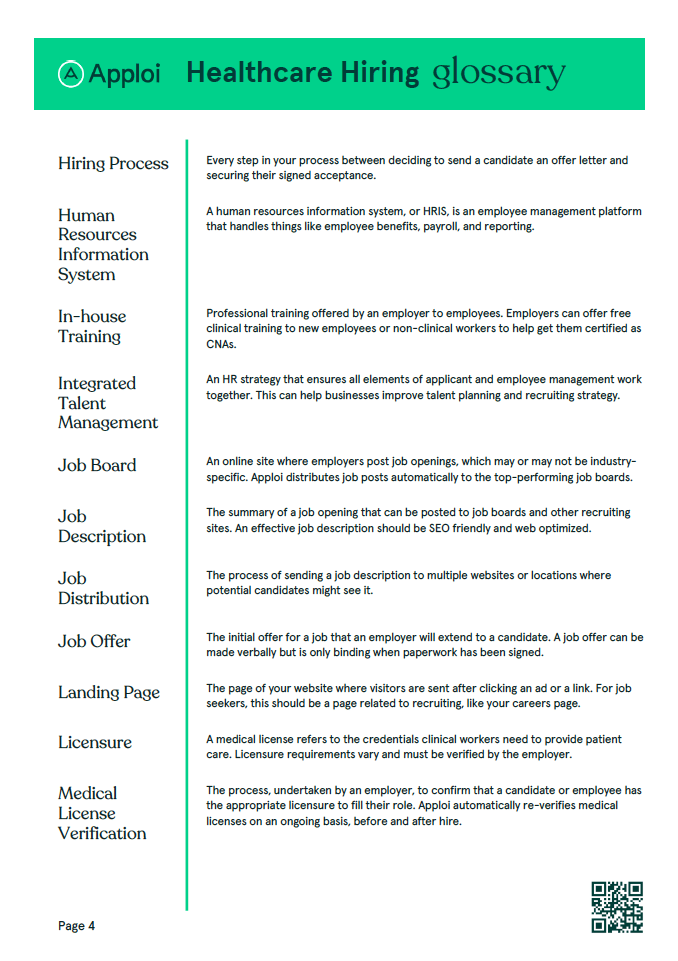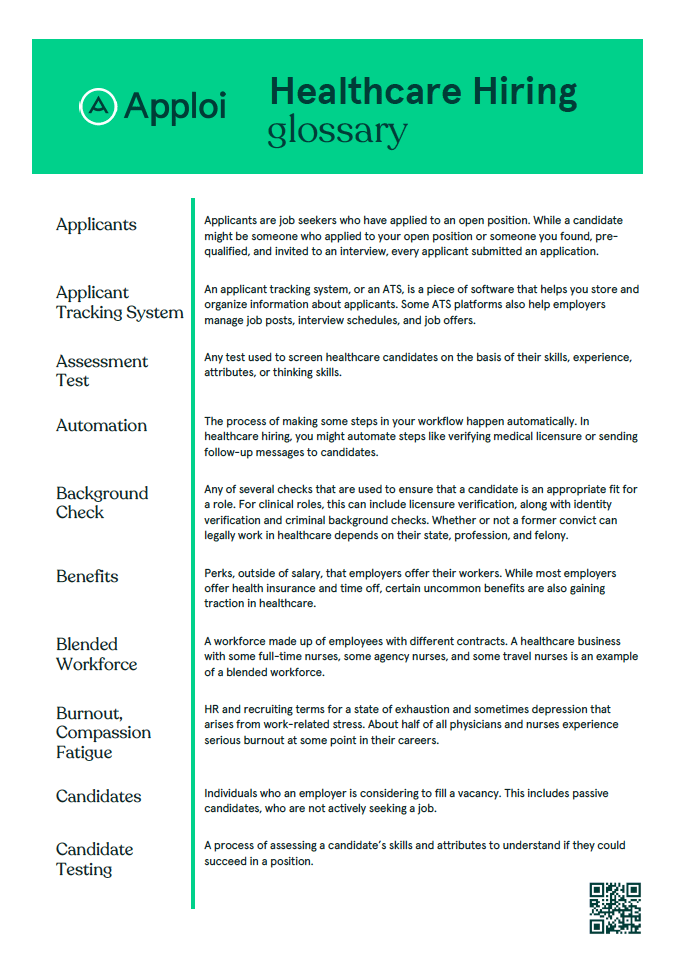
Healthcare Recruiting Terms: Your Digital Hiring Glossary
Healthcare recruiting is its own world. Demystify the process with this glossary of recruiting terms.

FREE TEMPLATES
Create effective job posts to attract more candidates with our free templates for RN, CNA, and LPN job descriptions
FREE PRINTABLE GLOSSARY
Download your free glossary to use later in learning
Healthcare Recruiting Terms
Applicants
Applicants are job seekers who have applied to an open position. While a candidate might be someone who applied to your open position or someone you found, pre-qualified, and invited to an interview, every applicant submitted an application.
Applicant tracking system
An applicant tracking system, or an ATS, is a piece of software that helps you store and organize information about applicants. Some ATS platforms also help employers manage job posts, interview schedules, and job offers.
Assessment test
Any test used to screen healthcare candidates on the basis of their skills, experience, attributes, or thinking skills.
Automation
The process of making some steps in your workflow happen automatically. In healthcare hiring, you might automate steps like verifying medical licensure or sending follow-up messages to candidates.
Background check
Any of several checks that are used to ensure that a candidate is an appropriate fit for a role. For clinical roles, this can include licensure verification, along with identity verification and criminal background checks. Whether or not a former convict can legally work in healthcare depends on their state, profession, and felony.
Benefits
Perks, outside of salary, that employers offer their workers. While most employers offer health insurance and time off, certain uncommon benefits are also gaining traction in healthcare.
Blended workforce
A workforce made up of employees with different contracts. A healthcare business with some full-time nurses, some agency nurses, and some travel nurses is an example of a blended workforce.
Burnout, Compassion fatigue
HR and recruiting terms for a state of exhaustion and sometimes depression that arises from work-related stress. About half of all physicians and nurses experience serious burnout at some point in their careers.
Candidates
Individuals who an employer is considering to fill a vacancy. This includes passive candidates, who are not actively seeking a job.
Candidate testing
A process of assessing a candidate’s skills and attributes to understand if they could succeed in a position.
Candidate experience
The way candidates perceive you as an employer while proceeding through the hiring process.
Candidate journey
Every step a candidate takes between becoming aware of your business and receiving a response to their application. During the candidate journey, candidates become aware of open positions, learn about your business, and decide to apply.
Candidate touchpoints
Any moment that your organization interacts with a candidate. More touchpoints can help candidates stay engaged and interested in your business.
Career branding
Everything that contributes to how a business’s career opportunities are perceived. Can include career pages, social media presence, and online visuals.
Care pool
Your healthcare talent network. The pool of candidates who have interacted with your jobs and may be ready to fill new vacancies. This recruiting term is specific to healthcare.
Clinical and non-clinical roles
Clinical roles directly deal with patient care (for example, nurses, physicians, and caregivers). Non-clinical roles do not (for example, secretaries, administrative workers, and human resources). Both clinical and non-clinical roles are vital to your patient’s care and experience.
Company culture
The collection of values and practices that shape how your workers experience your workplace.
Compliance
Staying in compliance refers to meeting all the standards placed upon healthcare organizations, legally and ethically. Healthcare organizations must comply with HIPAA, federal laws, and state laws.
Contract worker
A worker who is employed for the duration specified in a contract, rather than indefinitely. Travel nurses and daily agency nurses are two examples of contract workers.
Conversions
An action taken by a visitor to your website to show that they’re interested in your business. In recruiting, this might mean filling out an application or signing up for job alerts.
Cost per applicant
The average cost to recruit a single qualified applicant. You can estimate your cost per applicant by dividing your entire recruiting costs by the number of qualified candidates who apply for your job.
Cost per hire
The average cost to hire a single new employee. Calculated by dividing your total recruiting costs by the number of hires you make as a result.
Cost per thousand
The costs of getting a thousand interactions on digital ads. This can be both a pricing model used to predict costs and a reporting metric to help inform your future budget.
Credentialing
The process of verifying that clinical workers have all the proper certifications to hold their roles.
Direct hire, Direct placement
Recruiting terms that refer to a certain kind of hire. Direct hiring happens when an organization permanently hires a new member of staff through a staffing agency. A direct hire is treated like any other permanent employee, unlike a contract worker, who might either only work the duration of their contract or go through a contract-to-hire trial period.
Diversity, equity, and inclusion
Often grouped together, diversity, equity, and inclusion are actually three distinct values that emphasize the importance of difference in staffing. Diversity refers to the difference in background and thought that make up any group of people. Equity refers to the commitment to ensuring every individual is treated as an equal member of the team. Inclusion is the commitment to welcoming different thoughts, perspectives, and experiences.
Easy apply, 1-click apply
Two kinds of applications that can be completed very quickly. Easy apply options are helpful for competitive fields like healthcare where candidates may be browsing jobs between shifts.
Employee engagement
The process of keeping workers actively and positively engaged with their job and workplace. This can involve surveys, check-in meetings, and social events.
Employer brand reputation
Your reputation as an employer. How employees and candidates think of and talk about you.
Fill rate
The percentage of open roles that are filled by a new employee. In recent years, healthcare’s fill rate has dropped as low as 0.5, indicating that about half of all open positions were filled.
Flexible benefits
Benefit options that employees can select for themselves. Flexible benefits are used to enhance employees’ quality of life and attract more applicants.
Hiring process
Every step in your process between deciding to send a candidate an offer letter and securing their signed acceptance.
Human resources information system
A human resources information system, or HRIS, is an employee management platform that handles things like employee benefits, payroll, and reporting.
FREE PRINTABLE GLOSSARY
Download your free glossary to use later in learning
In-house training
Professional training offered by an employer to employees. Employers can offer free clinical training to new employees or non-clinical workers to help get them certified as CNAs.
Integrated talent management
An HR strategy that ensures all elements of applicant and employee management work together. This can help businesses improve talent planning and recruiting strategy.
Job board
An online site where employers post job openings, which may or may not be industry-specific. Apploi distributes job posts automatically to the top-performing job boards.
Job description
The summary of a job opening that can be posted to job boards and other recruiting sites. An effective job description should be SEO friendly and web optimized.
Job distribution
The process of sending a job description to multiple websites or locations where potential candidates might see it.
Job offer
The initial offer for a job that an employer will extend to a candidate. A job offer can be made verbally but is only binding when paperwork has been signed.
Landing page
The page of your website where visitors are sent after clicking an ad or a link. For job seekers, this should be a page related to recruiting, like your careers page.
Licensure
A medical license refers to the credentials clinical workers need to provide patient care. Licensure requirements vary and must be verified by the employer.
Medical license verification
The process, undertaken by an employer, to confirm that a candidate or employee has the appropriate licensure to fill their role. Apploi automatically re-verifies medical licenses on an ongoing basis, before and after hire.
Mentors
An individual, typically someone with notable professional experience, who offers support and guidance to another worker. Mentorships can be arranged formally or informally.
New hires
Employees who have joined their workplace recently and may still be adjusting to processes and best practices.
Onboarding process
The process of establishing a new employee in a workplace. Onboarding can include completing legally required paperwork, training, and meeting other workers.
Passive candidate
Someone who may be a good fit for a job that they are not actively seeking. Passive candidates are typically more difficult to recruit than candidates who are actively job-seeking, but they can be important in the fight against the healthcare talent shortage.
Pay-per-click
A payment model where a business pays an advertiser a specific amount each time a user clicks through an online ad.
Pre-screening, Pre-employment screening
A question or series of questions used to assess a candidate’s skills or experiences early in the application stage. Pre-screening questions are often a part of a quick apply process and may be used in place of cover letters.
Recruitment marketing
A recruiting strategy that uses marketing techniques to drive more applicants to jobs.
Referral program, Employee referral program
A program, run by an individual business, used to encourage employees to refer people in their social circle to job openings. Some businesses offer rewards, like monetary bonuses, to employees who refer candidates who then go on to accept job offers.
Retention rate
The percentage of employees who stay in their roles each year. Retention rates vary widely across different healthcare professions. Among nurses, burn care and women’s health have some of the highest retention rates, while emergency services and step-down care have some of the highest.
Return on investment
Return on investment, or ROI, is the measure of your monetary gains against the cost of getting those results. For recruitment, your return on investment is the monetary value added by a new hire weighed against the cost of recruiting and hiring them.
Right-to-hire, Temp-to-hire
During a right-to-hire period, a worker is employed through a staffing agency to work for a business, with the possibility of the business extending a permanent employment offer when the temporary contract ends.
Screening
The process of assessing a candidate through questions, application materials, interviews, or tests.
Silos
Work that is disconnected from the needs and actions of other teams, workers, or initiatives. When workers fall into silos, they don’t see the full picture impacting their business. They may wind up replicating work or failing to adjust to developing needs.
Social recruiting
A recruitment strategy that uses social media to connect with potential candidates.
Staffing
A collective term referring to all aspects of talent management, including recruitment, hiring, and employee operations.
Staffing ratios, Nurse-to-patient ratios
The ratio of care providers to patients that is required to ensure healthcare services are safe and legal. There is currently no federal law mandating staffing ratios. Also known as “safe staffing.”
Talent pipeline
A pool of candidates who are in the process of being assessed.
Talent planning
The process of planning for upcoming workforce development, retention, and recruiting.
Talent shortage
A talent shortage occurs when an industry has more open positions than qualified job-seeking candidates. Most healthcare professions are experiencing a talent shortage currently, due in part to Baby Boomers reaching retirement age. The Bureau of Labor Statistics projects that RNs alone will have 194,500 openings every year from now through the end of the decade.
Temporary workers
Workers who are employed on a temporary contract. Includes most agency workers and travel nurses.
Time-to-fill
The time it takes an employer to fill a vacancy. Time-to-fill includes the time it takes an employer to find a candidate. Therefore, it’s typically longer than time-to-hire. For healthcare, it takes an average of 49 days to fill a role.
Time-to-hire
The length of time between connecting with a candidate and officially hiring them as an employee. Time-to-hire can be improved with a quicker candidate screening and an efficient offer process.
Turnover rate
The percentage of employees who leave their business every year. In 2021, about 41% of RNs and 46% of CNAs left their jobs.
Workflows
A standard process for accomplishing a certain goal. A hiring workflow will typically include stages like screening, verifying licensure, completing a background check, and sending an offer letter.
Better Hiring With Apploi
Apploi helps employers source candidates, streamline hiring, and onboard new recruits. Hire painlessly to make a great impression on new applicants.
Interested in learning more about how you can recruit, hire, and onboard healthcare staff quickly? Contact us today for a free demo of our end-to-end talent management solution.





